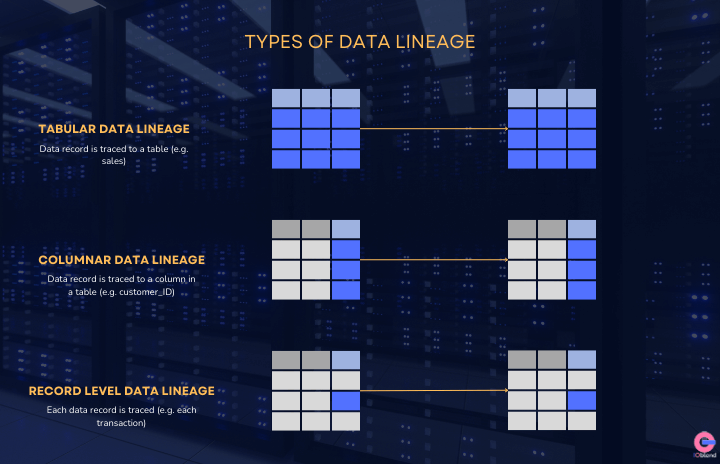Data Lineage: A Data Governance Must Have
The significance of data in today’s digital-driven landscape cannot be overstated. However, the value isn’t just in having vast amounts of data, but in understanding its journey from origin to endpoint. This brings us to the concept of data lineage, a vital component of data governance and management.
Why is Data Lineage Important?
Data lineage provides a comprehensive trace of data’s journey throughout its lifecycle – from its initial source, through various transformations and, finally, to its destination. The benefits include:
Data Integrity: Ensuring the sanctity of the data feeding into systems is paramount. Anomalies or inconsistencies can produce misleading results, affecting business decisions.
Enhanced Data Trustworthiness: Ensuring stakeholders trust the data-driven insights.
Fault Identification & Recovery: If systems go awry and corrupt data, knowing its lineage can expedite identifying the root cause and restoring it. Without lineage, pinning down such glitches can be like searching for a needle in a haystack.
Auditing & Compliance: From an auditing perspective, data lineage offers a clear trace of how data evolves and ensures that it complies with regulatory mandates.
Efficient Data Governance: Establish better data management and usage protocols.
Data Lineage is paramount in various industries:
Banking: A transaction data may originate from a mobile app, undergo validation checks, get processed in a central system, and finally reflect in a customer’s account statement. Tracing this path ensures transactional accuracy and integrity.
Healthcare: Patient data might come from various devices and systems, undergo processing for diagnosis, and be stored in health records. Mapping this journey ensures data consistency and patient privacy.
Aviation: It is crucial to ensure the accuracy of data related to flight schedules, aircraft maintenance, and passenger information. Data lineage is used to trace the history of this data to identify any potential errors or inconsistencies.
There are several ways to capture data lineage
Manual Documentation: Traditional method involving hand-drawn diagrams or spreadsheets.
Automated Data Lineage Tools: Use of specialized software to automatically discover, capture, and visualize data lineage. These tools then offer varying degrees of granularity:
- DAG, or visual, where you can see how your data flows through each stage of iterations
- Tabular, where you can trace the origins at a table level
- Columnar, that allows you to trace data within a column in a table (these are now being used in data lakes and warehouses)
- Record level, the most granular lineage, where you can trace the origin of each individual record (particularly important in audits and real time applications)

Unfortunately, as we’ve noticed at IOblend, many organisations often overlook data lineage, largely due to the rush to deploy new systems and data products. The initial urgency to launch often places higher priority on delivery than on the quality of data that fuels these systems. But such short-term vision inevitably results in long-term data challenges, impacting security, reliability, and decision-making.
The reason data lineage is often pushed back is due to the complexity of implementation. Crafting data lineage manually across all dataflows is massive, especially with live data streaming. The market offers data lineage tools, but the key is to find one harmonizing with your data landscape and providing desired granularity. Ideally, you want data lineage as part of your data pipeline tools, so you can monitor your data from source to sink in one go.
IOblend’s Approach to Data Lineage Automation
Since we have encountered data lineage issues on more than one occasion, we made data lineage an integral part of our solution. We do DataOps, and data lineage is DataOps. At IOblend, we made sure that the most granular data lineage is available to you ‘out-of-the-box’. It starts at record level with the raw data and maps the transformations all the way to the end target.
In addition to the DAG, we also tag every record at all stages of the data pipeline to monitor the “what”, “who”, “when” and “where”, making the full audit of the data quick and hassle-free. IOblend maintains “state” throughout, so it is always aware of any changes instantaneously and applies appropriate actions. Just visually design your dataflow and data lineage is applied automatically, every time. There is no additional requirement to setup or code data lineage policies or purchase additional tools.
Data lineage, though unfortunately often overlooked, is undeniably the backbone of reliable data systems. As businesses transition into data-driven entities, the significance of lineage becomes even more pronounced. With automated platforms like IOblend, the hope is that more organizations will adopt data lineage more widely and ensure a secure and transparent data future.
Download a FREE Developer Edition and see for yourself how simple data lineage can be to implement.
In the realm of real-time analytics, managing data lineage is essential to ensure data integrity and trustworthiness. Data lineage, a critical aspect of data governance, provides a trace of data’s journey throughout its lifecycle, from the source to various transformations and its final destination. This traceability is vital for several reasons: it ensures the sanctity of data feeding into systems, aids in fault identification and recovery, supports auditing and compliance, and establishes efficient data governance protocols. Different industries, such as banking, healthcare, and aviation, rely on data lineage to ensure transactional accuracy, data consistency, and patient privacy. While manual documentation has traditionally been used, automated data lineage tools now offer various degrees of granularity, including visual (DAG), tabular, columnar, and record-level lineage, essential for audits and real-time applications. However, the complexity of implementation can often lead to its oversight. IOblend addresses this challenge by integrating data lineage into its DataOps solution, offering out-of-the-box granular data lineage that tracks every record through data pipelines. This automation ensures a quick and hassle-free audit of data, maintaining state throughout the dataflow.

When Data Science Meets Domain Expertise
In the modern days of GenAI and advanced analytics, businesses need to bring domain expertise and data knowledge together in an effective manner.

Keeping it Fresh: Don’t Let Your Data Go to Waste
Data must be fresh, i.e. readily available, relevant, trustworthy, and current to be of any practical use. Otherwise, it loses its value.

Behind Every Analysis Lies Great Data Wrangling
Most companies spend the vast majority of their resources doing data wrangling in a predominantly manual way. This is very costly and inhibits data analytics.

Data Architecture: The Forever Quest for Data Perfection
Data architecture is a critical component of modern business strategy, enabling organisations to leverage their data assets effectively.

Mind the Gap: Bridging GenAI Promise and Practice
While the benefits of GenAI are promising, the path to adopting such technologies is not straightforward at all.

Data Automation: Investing Pennies to Save Pounds
Data automation is a critical enabler of efficiency, accuracy, and strategic insight. It also considerably lowers your business cost when producing said insight

